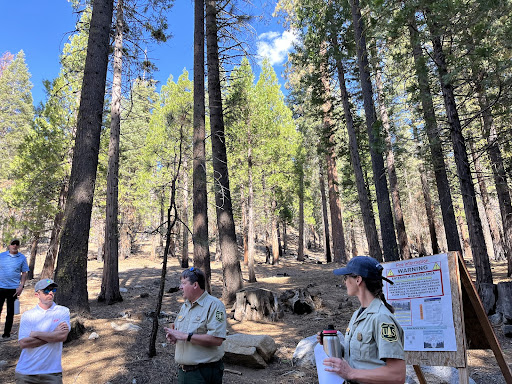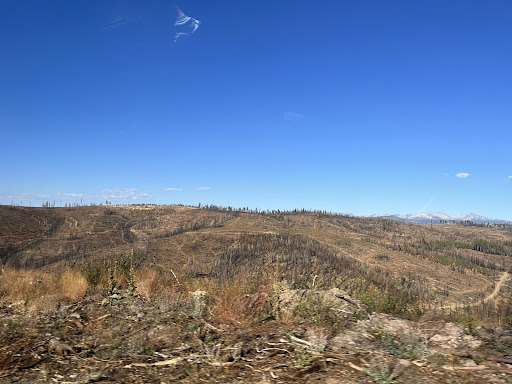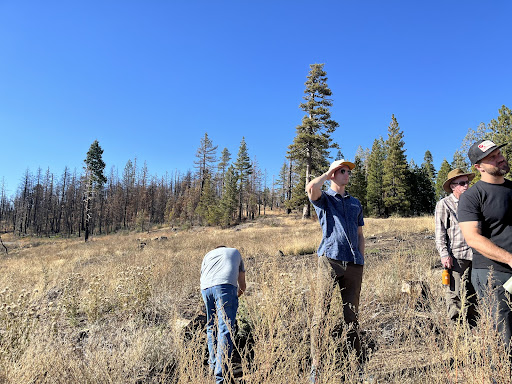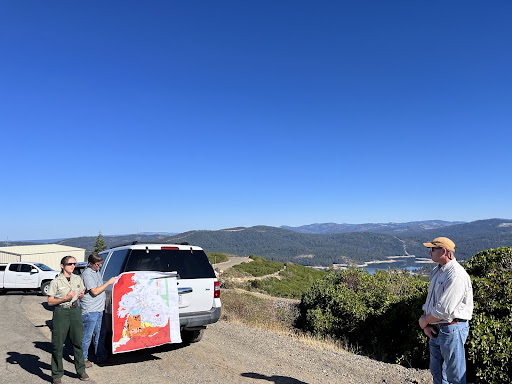



In early October, the Blue Forest team organized a field tour with our partners from the Healthy Eldorado Landscape Partnership (HELP), local public utilities, and some of Blue Forest’s investors to tour the forest resilience efforts underway in Eldorado National Forest following the 2021 Caldor Fire.
Photos and story by: Sabrina Chui, Project Associate and Matt Sjoholm, Director of Project Development, California
In early October, the Blue Forest team organized a field tour with our partners from the Healthy Eldorado Landscape Partnership (HELP), local public utilities, and some of Blue Forest’s investors to tour the forest resilience efforts underway in Eldorado National Forest following the 2021 Caldor Fire. Through the HELP initiative, the Eldorado National Forest is exploring opportunities to use conservation finance tools, like the Forest Resilience Bond (FRB), to accelerate the pace and scale of their forest restoration projects. This field visit was an opportunity to strengthen relationships amongst potential project partners, tour a few of the sites where future projects will take place, and learn about the growing need for sustainable infrastructure to handle the biomass coming off of forested landscapes.
The Eldorado National Forest tour took our group from Placerville to Twin Bridges and included many opportunities to observe the varied fire effects within the Caldor Fire footprint. High-severity burn areas covered large swathes of land, but pockets of green forest also made surprise appearances as we traveled through the Caldor Fire burn footprint. One of these pockets was the location of the 2019 Caples Prescribed Burn – a previous prescribed burn site near the Caples Creek Trailhead. Because the area experienced low-intensity fire in previous years, there were far lighter forest fuel levels in the Caples burn footprint. These reduced fuel levels played an important role in slowing the advance of the Caldor Fire and the decreased severity of the Caldor Fire within the Caples burn footprint illustrated the importance of fuels reductions projects in mitigating the effects of high-severity wildfires.
During another stop on the tour, our group visited the Crystal Basin lookout, which offered sweeping views of the Crystal Basin – an area unaffected by the Caldor Fire. There, Ethan Koenigs, Project Manager at Sacramento Municipal Utility District, elaborated on our water infrastructure’s reliance on healthy forests. The contrast between the unburned Crystal Basin and the immediate fire footprints outside of Crystal Basin highlighted the opportunity for companies like water and power utilities to support watershed restoration projects that reduce fire risk in areas that impact their infrastructure and business operations.
The group also visited the Sierra-at-Tahoe ski resort to learn about the impacts of the Caldor Fire on the business. Though the resort was armed with snow machines and large ski runs that acted as fuel breaks, the extreme conditions of the Caldor Fire burned through 80% of the vegetation on the resort’s property, mostly at high severity. Sierra-at-Tahoe not only suffered infrastructure damages from the Caldor Fire but also had to remain closed for the 2021-2022 winter season. As a result, the surrounding local economy experienced losses in tourism revenue and employment opportunities. Given Sierra-at-Tahoe’s important role in the local economy and the goal of re-opening this winter season, salvage logging and hazard tree removal are top priorities to ensure the safety of visitors. Looking forward, high-severity wildfires at higher elevations are becoming increasingly common, a stark reminder that recreation companies, such as ski resorts, are just as reliant on healthy forests as our public utilities.
To end the tour, our group of partners stopped by the Sierra Springs Fire Station to discuss how prior fuels reduction projects helped protect the town of Pollock Pines as the Caldor Fire burned in the surrounding areas. We also reflected on both the sobering scenes we witnessed during the tour and the promising opportunities that lie ahead to accelerate fire recovery and forest resilience efforts on the Eldorado National Forest. A couple of these opportunities include attracting funding for forest restoration projects and channeling investments toward biomass businesses that can use the excess biomass removed from forests during fuels reduction projects.
Overall, the field tour of the Eldorado National Forest was a valuable learning experience for both investors and the Blue Forest team. It was important for our investors to see how wildfire behavior is dependent on forest health treatments and to better understand the complexity of a fire footprint. For our team, this was also a meaningful opportunity to learn more about our project partners and the forest restoration work they are planning on the Eldorado National Forest. We left optimistic about the opportunities for conservation finance to aid in these efforts and excited to see what projects we can build together in the months ahead.